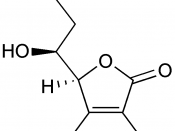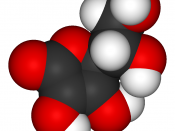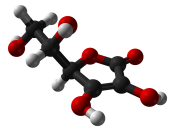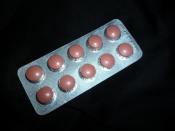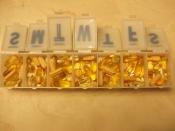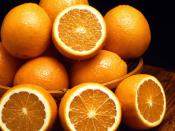Finding fruits containing highest amount of vitamin C contentIntroductionTo understand this lab, the knowledge of what vitamins are should be explained first. "Vitamins are organic (carbon containing) molecules that mainly function as catalysts for reactions within the body" (http://www.howstuffworks.com/vitamin-c.htm). Vitamins are organic substances, which mean that they are made by plants or animals. Vitamin C, also known as ascorbic acid, is a water-soluble vitamin. It is necessary for normal growth and development. The body some what relies on vitamin C to form collagen in bones, cartilage, muscle, and blood vessels and aids in the absorption of iron. "Dietary sources of vitamin C include fruits and vegetables, particularly citrus fruits" (http://www.nlm.nih.gov/Medline plus/druginfo/natural/patient-vitaminc.html).
PurposeTo determine the vitamin C content of various fruits and to find out which fruit has the highest vitamin c content.
HypothesisIt was hypothesized that lime will have the highest vitamin C content due to it being part of the citric group and its low acid levels.
To add on, lime tastes very sour and this could be due to that it has a low acid level, which relates to the vitamin C content. It was also hypothesized that orange will have the second most vitamin c content because it is also part of the citric group. Tomato will have the third most vitamin c content because it has a sweet taste to it, which can contribute to it possibly having a lower vitamin C content. It is also not part of the citric group. It was also hypothesized that mango will have the forth most vitamin C content due to that it is very sweet, and this could possibly indicate how much vitamin C content there is. Lastly, apple will have the fifth most vitamin C content because it might be rich in other vitamins.
Procedure1. Use a pipette to transfer 0.5 ml of 0.200 mg/ml vitamin C solution to the first well of a 24-well plate. Repeat for the 0.400, 0.600, 0.800, and 1.00 mg/ml solution to the wells.
2. Add three drops of starch solution indicator to each of these wells.
3. Place the plate on top of the white paper to better observe. Use a thin pipette to add the iodine solution drop by drop to the 0.200 mg/l vitamin C solution. Count the drops! When the first solution turns to a permanent dark colour, the titration has been completed.
4. Produce a graph illustrating iodine drops vs. Vitamin C concentration. Draw a line of best fit.
5. Take each fruit and blend them individually to obtain a water solution.
6. Repeat steps 1-3 with each of the fruits. Be sure to rinse the pipette between samples. Record the number of drops in Data Table #1 then use the graph to determine the specific vitamin C concentration for each fruit.
7. Clean up (rinse the plates out in the sink immediately).
Material:LimeOrangeAppleMangoTomatoThin-stem pipetteGraduated pipetteMicro-stirring rod24-Well plateVitamin C concentrations (0.200,0.400,0.600,0.800,1 mg/ml)Starch indicatorIodine SolutionObservationsTable 1: Chart showing the amount of iodine drops taken to titrate different fruits. This information was compared with the stock solution.
Stock Solution: Vitamin CFruitsVitamin C (mg/ml) Iodine dropsFruit Iodine Drops0.200 2Orange 230.400 3Apple 20.600 13Mango 90.800 17Tomato 71.00 22 Lime 28By observing the table above, a lot of information is given about the vitamin C content of each fruits. The difference of vitamin C in each fruit is sort of substantial as there are great differences between some fruits. Other fruits have similar vitamin C content as to others.
ResultsFigure 1: A graph showing how much vitamin C each fruit has.
DiscussionSome fruits may have higher vitamin C levels than other fruits due to the natural vitamins that the fruits contain. Some fruits may be rich with vitamin C but lack other vitamins and vice versa. The fruit itself can contain vitamin C and have a lot of it or little. By conducting this lab, we found out which fruits had a lot of vitamin C comparing to fruits that had very little vitamin C. It basically depends on the type of fruit.
There may have been a few sources of error:- Contamination of juices- Contaminated well-plate- Incorrect measurement of solutions- Incorrect measurement of iodine drops poured- Using fruits that are not ripe.
Improvements: One improvement that can be made to this lab is using ripe fruits as they contain more vitamin C, and this contributes to better results.
ConclusionIn overall, the hypothesis stated was incorrect. Everything stated in the hypothesis was correct except that mango had the third most vitamin C content instead of fourth most vitamin C content. Also, we found out that tomato had the fourth most vitamin C content, which meant that mango had more vitamin C than tomato. All other rankings in the hypothesis were correct.
AppendicesFinding percent of vitamin C each fruit contains with recommended daily vitamin C intake.
Lime:1.3 mg ascorbic acid (250 mL)/60mg *100= 542 %Orange: 1.02 mg ascorbic acid (250 mL)/60mg *100= 425 %Mango:0.5 mg ascorbic acid (250 mL)/60mg *100= 208 %Tomato:0.44 mg ascorbic acid (250 mL)/60mg *100= 183 %Apple:0.18 mg ascorbic acid (250 mL)/60mg *100= 75 %ReferencesGordon, D. J. (n.d.). HowStuffWorks "How Vitamin C Works". Retrieved June 11, 2009, from http://www.howstuffworks.com/vitamin-c.htmMedlinePlus Herbs and Supplements: Vitamin C (ascorbic acid) . (n.d.). Retrieved June 11, 2009, from http://www.nlm.nih.gov/medlineplus/druginfo/natural/patient-vitaminc.htmlVitamin C and Citrus Juices. (n.d.). Retrieved June 11, 2009, from http://www.ultimatecitrus.com/vitaminc.html
